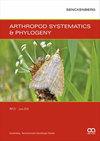喀麦隆火山线的天空岛屿支持五种新的台风象甲的最西端分支(鞘翅目:弯甲科:Molytinae)
IF 1.8
2区 农林科学
Q2 ENTOMOLOGY
引用次数: 1
摘要
台风象甲属是刚果盆地西部首次报道的象甲属。对一个线粒体和两个核片段的2136个对齐位置的分析揭示了五个喀麦隆新物种的适度支持的分支:T.ampion sp.nov.(Mt.Oku)、T.cantus sp.nov.[Mt.Oku]、T.clytius sp.nov..(Mt.Cameron)、T.iphitus sp.nov.\(Mt.Kupe)和T.telamon sp.nov.[Mt.Kupe]。使用固定替代率对20个DNA条形码片段进行分子钟分析,估计该分支内的分歧发生在中新世中期至晚期(1050万至540万年前,MYA),该时期早于上新世-更新世全球气候波动和非洲森林规模波动的相应周期。这种相对较旧的日期是出乎意料的,可能反映了时间分析的四个不可避免的缺点:1。取样不足的组,2。缺乏喀麦隆火山线其他动物分支的比较时间数据,3。使用单一母系遗传的蛋白质编码标记的固定速率分子钟方法的过于简单化。当使用大量饱和的线粒体序列时,可能高估了相对较老的年龄。来自刚果共和国的两种不知名的象甲被假设属于典型象甲属:T.distinctus(Hoffmann,1968)comb。nov.(来自Anchonidium亚属Neoanconidium)和T.baloghi(Hoffmann,1968)梳。nov.(来自亚扁尾亚属Anchonidium)。三个属群名称在Typoderus下被新同义:Entymoderus Voss,1965 syn。nov.(Typoderus唯一的非主格亚属),Neoanconidium Hoffmann,1968 syn。nov.(Anchonidium的亚属)和Subanchonidium Hoffmann,1968 syn。nov.(Anchonidium的亚属)。所有测序标本的习性图像和其他补充信息可在线访问dx.doi.org/10.5883/DS-VGDS005和dx.doi..org/10.5883/DS-VGDS006。本文章由计算机程序翻译,如有差异,请以英文原文为准。
Sky islands of the Cameroon Volcanic Line support the westernmost clade of five new Typoderus weevils (Coleoptera: Curculionidae: Molytinae)
The weevil genus Typoderus is for the first time reported west of the Congo basin. Analysis of 2,136 aligned positions from one mitochondrial and two nuclear fragments revealed a moderately supported clade of five new Cameroonian species: T. amphion sp. nov. (Mt. Oku), T. canthus sp. nov. (Mt. Oku), T. clytius sp. nov. (Mt. Cameroon), T. iphitus sp. nov. (Mt. Kupe) and T. telamon sp. nov. (Mt. Kupe). Molecular clock analysis of 20 DNA barcode fragments using a fixed substitution rate estimated divergences within this clade to be during the Middle to Late Miocene (10.5–5.4 million years ago, MYA), which pre-dates the onset of the Pliocene-Pleistocene global climatic fluctuations and corresponding cycles of African forest size fluctuation. Such relatively old dates are unexpected and might reflect four unavoidable shortcomings of the temporal analysis: 1. undersampled ingroup, 2. scarcity of comparative temporal data for other animal clades from the Cameroon Volcanic Line, 3. oversimplification of a fixed-rate molecular clock approach using a single maternally-inherited protein-coding marker and 4. possible overestimation of comparatively old ages when using largely saturated mitochondrial sequences. Two obscure weevil species from the Republic of the Congo are hypothesized to belong to the genus Typoderus: T. distinctus (Hoffmann, 1968) comb. nov. (from Anchonidium subgenus Neoanchonidium) and T. baloghi (Hoffmann, 1968) comb. nov. (from Anchonidium subgenus Subanchonidium). Three genus-group names are newly synonymized under Typoderus: Entypoderus Voss, 1965 syn. nov. (the only non-nominative subgenus of Typoderus), Neoanchonidium Hoffmann, 1968 syn. nov. (subgenus of Anchonidium) and Subanchonidium Hoffmann, 1968 syn. nov. (subgenus of Anchonidium). Habitus images and other supplementary information of all sequenced specimens are available online at dx.doi.org/10.5883/DS-VGDS005 and dx.doi.org/10.5883/DS-VGDS006.
求助全文
通过发布文献求助,成功后即可免费获取论文全文。
去求助
来源期刊

Arthropod Systematics & Phylogeny
Agricultural and Biological Sciences-Insect Science
CiteScore
2.50
自引率
5.60%
发文量
26
审稿时长
12 weeks
期刊介绍:
Arthropod Systematics & Phylogeny releases three times per year. Research fields covered are the taxonomy, morphology/anatomy, phylogeny (molecular or morphology-based), historical biogeography and palaeontology of arthropod taxa.
Arthropod Systematics & Phylogeny is the successor of Entomologische Abhandlungen, formerly published by the Museum of Zoology Dresden, Germany.
 求助内容:
求助内容: 应助结果提醒方式:
应助结果提醒方式:


